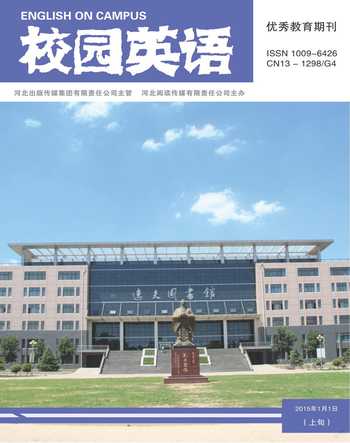Teaching Plan for Lesson 2 Beijing Opera (Unit 5 Rhythm)
杨沫华
Teaching Aims
1.To practise using general knowledge to think of possible answers before listening
2.To practise getting the general idea when listening for the first time.
3.To practise identifying key words to listen for.
Teaching Important Points
1.To improve students listening ability.
2.Enable the students to understand information about Beijing Opera
Teaching Difficult Point:
Students many be unfamiliar with the topic Beijing Opera and may find it hard to understand the interview
Teaching Methods
Enjoy music of Beijing Opera and a short passage about Beijing Opera to get the general idea about it .
Elicit students to predict the answers before listening
Teaching Aid
A multimedia
Teaching Procedures
Step I Greetings
Step II Lead-in
First , let the students enjoy a piece of music of Beijing Opera. Remind them to pay attention to the music , the voice ,the tone and the dress of the actor.
Second , let the students read a short passage about Beijing Opera to get more information about it (show the screen )
Peking opera of China is a national treasure witha history of 200 years.In the 55th year of theQing Dynasty(1790) ,the four big Huiban operaTroupes entered the capital and combined withKunqu opera, Yiyang opera, Hanju opera and Luantan in Beijing's thearetical circle of the time.Through a period of more than half a century ofcombination and integration of various kinds of opera there evolved the present Peking opera, the biggest kind of opera in China.
Third , show pictures of four main roles in Beijing Opera and make the students match the words with the pictures.
Step III Guessing
Students look at the picture and try to guess where the characters are.
Picture A ( She is on a horse)
Picture B (They are in a city)
Step IV Learning
First , students look at the pictures to learn some new words in this lesson : mask, costume, acrobatics, treasure, combine
Second ,students use the words to complete the sentences.
1.This golden ring is a real ________.
2.My mother sewed my _________ for the school play.
3.I love watching __________ but it looks very difficult!
4.The first step in making a cake is to ________ the milk and butter.
5.The singer wore a ________ that was made of wood.
Step V.Listening
Before listening, get the students to learn about the listening strategies
Before listening, read the questions.
Use your general knowledge to think of possible answers.
Listen and identify key words to help you answer the questions.
The first time you listen, try to get the general ides and take notes.
The second time you listen, listen carefully and try to note down the answers.
Listening for these questions
1.What skills do Beijing Opera actors need to have?
(Acting, talking, singing, dancing and acrobatics)
2.Where was Beijing Opera performed at the beginning?
(On open-air stages in markets, streets ,teahouses or temple courtyards.)
3.Why does it have very loud music and a sharp singing style?
Because at the beginning, Beijing Opera was performed mostly on open-air stages, the orchestra had to play loudly and the performers sing in piercing voices.
4.Why do performers wear brightly coloured costumes?
Because with bright color, their costumes are more impressive and the crowd can see them more clearly.
Read and listen to the last part of the programme.Then answer the questions.
1.What does the stage look like in Beijing Opera? Very simple
2.How do symbols play an important role in Beijing Opera?
Because symbolism plays an important role in Beijing Opera.
Step VI.Summary and homework
Today we have learn more about Beijing Opera and we do the listening to improve your listening skills .Also we learn some new words .After class , you can get on line to get more information about Beijing Opera and try to write a short passage about it .
教学设计和教学反思
本课是一节听力课,材料中的生词较多,学生对于京剧这个话题又不是很熟悉,加上本身基础又不是很好。完成练习的难度很大。
为了解决这个难题,保证学生在听力之前有足够的语言输入,同时为了提高学生对京剧这个话题的兴趣,我在课前导入时先放了一段京剧,在学生欣赏京剧片段的同时,提醒他们注意京剧的唱腔特点和演员的服装,使他们对于京剧先有一点感性的认识,然后我又提供一段材料让他们加深对京剧文化的理解。接下来设计了一个配对的练习。考查学生对 京剧角色的认识。对于听力中出现的大量生词,我用图片的形式很直观地让学生有了一个了解。接下来又设计了一个选词完成句子的练习,考查学生对生词的理解。在以上所有准备完成之后,才让学生开始听力练习,当然,在这之前,根据新教改的要求,我特地又带他们回顾了一遍他们所学习的听力策略,并要求他们在听力过程中运用听力策略。
由于准备很充分,学生能够顺利地完成本课的教学任务,我也圆满地达成了教学目标。只是后来学生反应在放映京剧唱段时若能够把曲词呈现出来会更好,因为有些学生说没有听懂曲词。还有在检查学生的课后作业时我发现,作文的难度偏大,或许我应该在让学生写这篇作文时给他们提供更多的语言支持,把必要的词汇呈现出来。或者让他们分小组讨论以后再写,最好我应该给他们一篇范文以供他们参考,这样学生可能就不会觉得这篇作文无从下手了。

